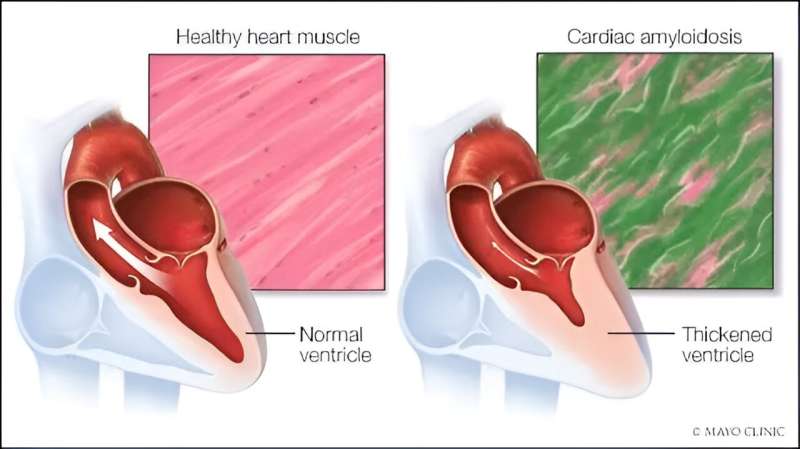This article has been reviewed according to Science X's editorial process and policies. Editors have highlighted the following attributes while ensuring the content's credibility:
fact-checked
trusted source
proofread
Cardiac amyloidosis: Why early diagnosis and targeted treatment matter

Amyloidosis occurs when the body produces abnormal proteins that bind together to form a substance called amyloid. Amyloids can deposit in any tissue or organ, including the heart, kidneys, liver and nerves. When it occurs in the heart, it's called cardiac amyloidosis.
Dr. Martha Grogan, a Mayo Clinic cardiologist and director of the Cardiac Amyloid Clinic at Mayo Clinic in Rochester, Minnesota, explains what cardiac amyloidosis is, why knowing the type of amyloid is key to treatment, and what's on the horizon to help patients with this rare condition.
When amyloid collects in the heart muscle, it causes thickening of the heart wall and disrupts heart function. It reduces the heart's ability to fill with blood between heartbeats, resulting in less blood being pumped with each beat and higher pressures in the heart chambers.
"The heart is the most important abnormality in amyloidosis because if the heart is affected, that is the complete driver of how the patient will do and what their prognosis is," says Dr. Grogan. "That's why cardiac amyloidosis is so important to recognize and treat as early as possible. The key thing, once a clinician suspects amyloid, is that it's a medical emergency."
Three types of amyloids can affect the heart:
- Light chain amyloid is produced in the bone marrow, progresses quickly and has the worst prognosis.
- Wild-type transthyretin amyloid (TTR) is produced in the liver and is the most common. This type typically shows up in men over 60, however women may also develop this condition.
- Hereditary type transthyretin amyloid is caused by a gene mutation and is considered rare, except in Black Americans. Not everyone with the gene variation will get the condition.
Dr. Grogan says amyloidosis is tricky to diagnose. At first, there are no symptoms. Later, the symptoms often imitate other conditions.
"We need to get to the bottom of: Does the patient really have amyloidosis or not? And then after, we do a series of tests. We need to figure out for sure what type of amyloid it is. We can't be guessing at what type because the treatment completely depends on the type," says Dr. Grogan.
For light chain amyloidosis, treatment is directed at the bone marrow and may include chemotherapy or stem cell transplant with a patient's own cells. Treatment for transthyretin amyloidosis aims to stabilize or reduce the amount of amyloid being produced from the liver.
There are current clinical trials of medication that will try to actively take the amyloid out of the heart, but they're not yet approved. However, Dr. Grogan says the future looks bright.
"These new medications are very exciting. In fact, that area of amyloidosis research is truly an explosion, there is so much going on. We went from very few options to so many options. We need to keep testing these and studying these," says Dr. Grogan.




















